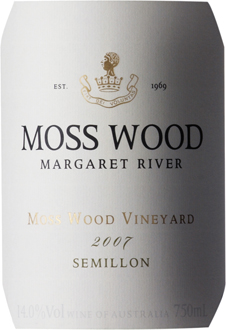Moss Wood 2007 Semillon

Wine Facts
| Harvested: | 14/2/2007 |
| Bottled: | 08/6/2007 |
| Released: | 07/11/2007 |
| Yield: | 7.68 t/ha |
| Baume: | 12.50 |
| Alcohol: | 14.00% |
| Vintage Rating: | 9/10 |
SOLD OUT
Tasting Notes
Bright, medium-straw in colour, fresh aromas of citrus, fig leaf, tobacco, limes and lanolin; medium to full bodied with great texture, fig and citrus flavours filling the mid-palate before a finish that features fresh, linear acidity. Good phenolics on the finish that add length and texture and the wine leaves a finish which is searingly fruity.
Moss Wood 2007 Semillon – Thebuyer.net, Roger Jones
Nutty, guava, slightly more tropical, evolved well and drinking nicely, this was perfectly matched to a Sea Bream Carpaccio later with lunch. The freshness of the fish lifted the wine to another level and showcased how good these Semillons are with vibrant seafood dishes. Published November 22, 2018 Source
Moss Wood 2007 Semillon – Julia Harding, jancisrobinson.com
Delicate herbaceous aroma, some green pea and grapefruit. Dry, chalky texture and subtle herbaceous flavours on the palate. Cool climate but not excessively green. Long and delicious in a very specific WA style.
Background Notes
There’s been a great deal of musing at Moss Wood since the major vertical tasting last November at which we tasted all the vintages of Moss Wood Semillon from 1985 to 2006. The general feeling has been that over the past ten years the style of the wine has become deliberately riper and this has limited its green characters.
This has raised something of a dilemma because these are vital if the Moss Wood Semillon is to continue to be a cellaring proposition. The historical view suggested the best of the estate’s Semillons are those where the wine has retained the last of the green fruit notes rather than those where we waited a few extra days, so they disappear. This change in approach has the potential to introduce a paradox. In slow-ripening, cooler years (like 2006 or 2002), the grapes will be picked riper and the final alcohol content of the wine will be higher because the greener flavours are retained for longer. In contrast, the green notes are likely to disappear faster in warm years (like 2003), leading to an earlier and potentially lower ripeness at harvest, with a commensurate reduction in final alcohol. It is therefore likely that the ripeness of the grapes and the final alcohol will continue to vary from year to year.
All this musing has led us to conclude that, in order to encourage the ageing ability of the Semillon, we needed to review picking criteria, harvest baume and flavour ripeness. You will see from the following notes that this is what we proceeded to do.
Vintage Notes
The 2007 vintage (with 15th February as the mean harvest date) was the earliest on record (with 1988 in second spot on the 22nd). It was the product of early flowering - the 98 days from flowering to harvest is normal. The season was superb although yields were well down - as the bunch weight reflected. Average bunch weight for the semillon was 170 grams against the long term average of 200 grams. Quality was excellent with the only disappointment being the small volumes.
Production Notes
There were some changes to our approach to Semillon this year, each block was picked according to revised criteria: catching the grapes just before the green characters are lost. There were also some changes to the production techniques with no whole bunch pressing as we returned to the more traditional technique of destemming before pressing. This gives a small amount of skin contact as the fruit goes through the press and has the added advantage of speeding up the process. Fermentation took place as normal in stainless steel tanks held at 18°C, with weekly lees stirring. After the fermentation had been completed, there was a reduction in the amount of lees stirring to emphasise the wine’s primary fruit notes. Before bottling it was fined for protein stabilisation (using bentonite) and tannin (using isinglass). It was sterile filtered and bottled on 9th June 2007.
Cellaring Notes
The youthful fruit flavours make it a very attractive short term prospect but its depth and structure certainly underpin good cellaring potential. We would recommend a minimum of 10 years.
